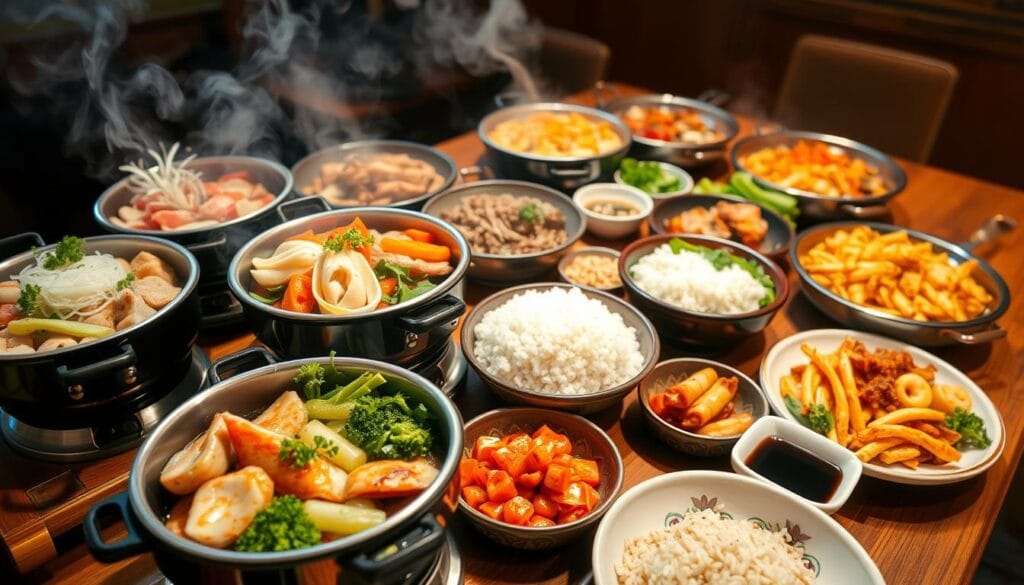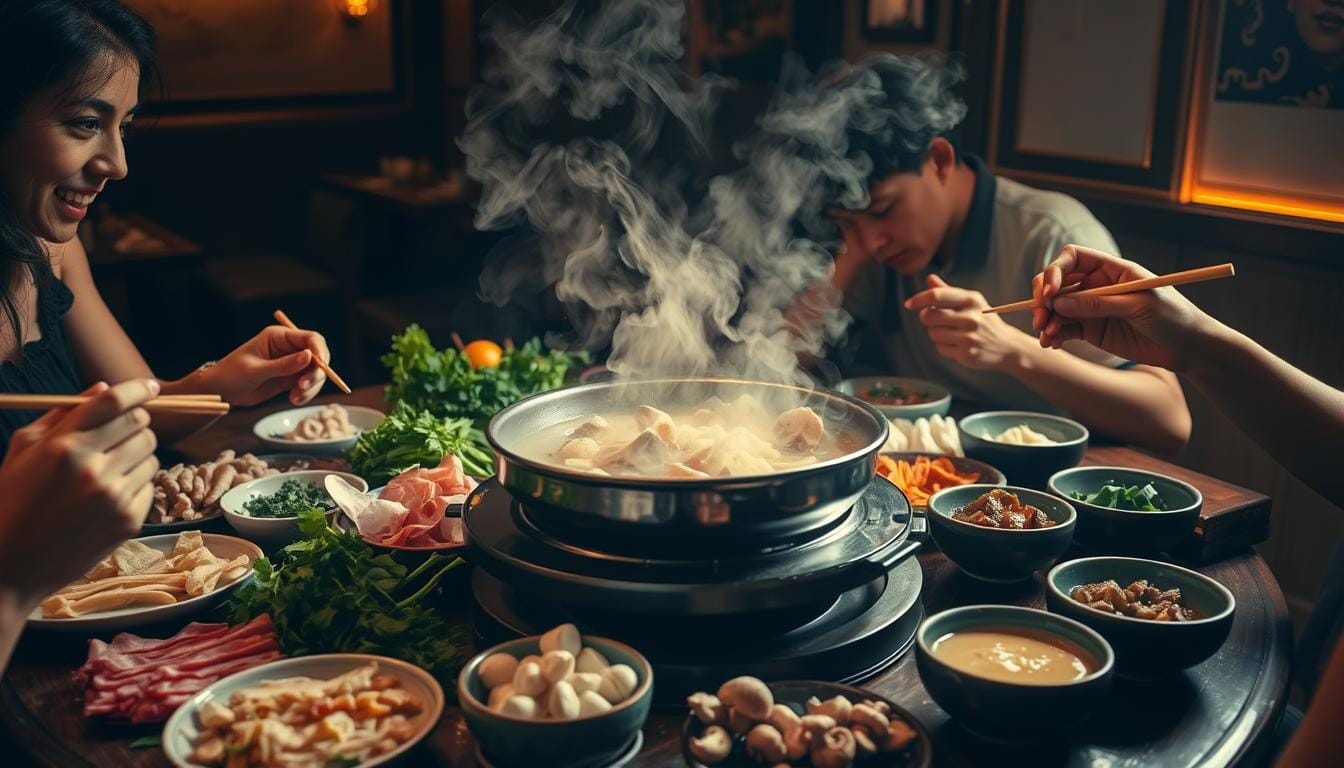Have you ever sat around a table, filled with laughter and savory smells? Friends and family gather to share a meal. This is the essence of the Hot Pot experience—it’s more than just food, it’s a celebration of connection and culture.
The bubbling broth at the center invites you to dive in. You cook fresh ingredients right at your fingertips. Whether it’s a cozy winter night or a summer gathering, authentic hot pot makes any meal special.
Get ready to explore the vibrant world of Asian hot pot. Every shared bite tells a story of tradition and taste.
Table of Contents
Key Takeaways
- Hot Pot is a communal dining experience that brings people together.
- It features a simmering pot of broth where diners cook ingredients in real-time.
- Exploring different flavors and styles of hot pot can enhance your culinary adventures.
- Authentic hot pot varies by culture, with unique tastes and preparation methods.
- The Hot Pot experience encourages interaction and sharing among diners.
Introduction to Hot Pot Cuisine
Hot pot cuisine is becoming more popular worldwide. It offers a unique dining experience for food lovers. Imagine a meal where everyone cooks their own food in a shared pot of flavorful broth.
This way of eating lets you be creative. You pick your favorite ingredients to go with the soup. It’s a fun way to make your own dish.
What is Hot Pot?
Hot pot is a meal where you cook ingredients in a simmering broth. You choose from meats, veggies, seafood, and noodles to add to the pot. This makes your meal just right for you.
It’s a great way to enjoy food with others. It’s perfect for sharing with friends and family. Everyone can have fun and try different things.
The Origin and History of Hot Pot
The history of hot pot goes back thousands of years to ancient China. People used to cook meals together over an open flame. This tradition has grown into the many hot pot styles we enjoy today.
Each region in China has its own twist on hot pot. They use local flavors and ingredients. Knowing the history of hot pot helps you appreciate its cultural value and how it brings people together.
The Varieties of Hot Pot
Hot pot is a world of flavors and styles, shaped by local traditions. Each variety offers a unique taste, thanks to different cooking methods and ingredients. This makes every hot pot experience special.
Chinese Hot Pot Styles
China’s hot pot styles are as varied as its regions. Sichuan’s hot pot is known for its spicy mala broth. It’s made with Sichuan peppercorns and chili peppers, giving a numbing and spicy taste.
In contrast, Beijing’s hot pot is milder. It focuses on the natural flavors of meat and vegetables, without the intense spice. This invites diners to enjoy a communal and flavorful meal.
Japanese Hot Pot Dishes
Japanese hot pot, or “nabemono,” is all about simplicity and freshness. It includes dishes like shabu-shabu, where meat and vegetables are quickly cooked in a light broth. Another favorite is sukiyaki, with its sweet soy sauce-based broth.
These dishes show the importance of quality ingredients and balance. They offer a different taste compared to the bold flavors of Chinese hot pot.
Korean Hot Pot Traditions
Korean hot pot, or “jjigae,” is all about sharing. It often has a mix of seafood, tofu, and vegetables, with spicy gochujang or doenjang for flavor. Famous dishes like budae jjigae combine leftover meats, kimchi, and vegetables.
This cuisine is about sharing and comfort. It’s a favorite for gatherings, bringing people together with its heartfelt flavors.

Key Ingredients for Authentic Hot Pot
To make a real hot pot, picking the right ingredients is key. Each part adds its own taste and makes the meal better. Choose a mix of meats, veggies, herbs, and broths to make your meal special.
Meats and Proteins
Meats and proteins add depth to your hot pot. You can use:
- Thinly sliced beef
- Pork, often enjoyed as belly or shoulder cuts
- Lamb, known for its distinct flavor
- Seafood, including shrimp, fish fillets, and scallops
- Specialty ingredients like offal, such as beef tripe and pork intestines, add unique textures and flavors
Vegetables and Herbs
Vegetables and herbs balance the richness of meats. Try using:
- Leafy greens like bok choy and spinach
- Root vegetables such as daikon and carrots
- Mushrooms, which absorb the flavors of the broth
- Herbs like cilantro and green onions for added freshness
Broths and Soups
Broths and soups are the heart of hot pot. You can choose from:
- Spicy broth infused with Sichuan peppercorns and chili oil
- Miso or soy-based broth for a milder flavor
- Coconut curry broth for a rich and aromatic experience

Popular Hot Pot Recipes
Hot pot is a world of flavors, showing off different cooking traditions. You can try Sichuan hot pot, shabu-shabu, and budae jjigae. Each dish offers a unique taste, from spicy to savory, perfect for any meal.
Sichuan Spicy Hot Pot
The Sichuan hot pot is known for its bold mala broth. It’s made with garlic, ginger, and spices like fenugreek and star anise. You’ll enjoy lamb, tofu, corn, and mushrooms in this dish. It’s a thrilling choice for those who love strong flavors.
Japanese Shabu-Shabu
Shabu-shabu is a light and fresh hot pot dish. It features thinly sliced meats cooked in a flavorful broth. This Japanese dish focuses on quality, with seasonal veggies and sauces. It’s a meal that lets each ingredient shine.
Korean Budae Jjigae
Budae jjigae, or army stew, is a mix of Korean hot pot and Western ingredients. It includes sausages, spam, and kimchi. This hearty stew has a spicy broth that’s great for sharing with others.

Choosing the Right Hot Pot Restaurant
Finding the perfect Hot Pot restaurant is key to a great dining experience. Look at several factors to ensure your meal is satisfying. First, check the variety and quality of broths. A good selection can make your meal even better.
Also, fresh ingredients are a must. Choose places that get their meats, veggies, and seafood every day. The atmosphere matters too. A friendly setting makes sharing meals with others more fun.
Other things to consider are customizable spice levels and all-you-can-eat deals. These can make your visit even better.
What to Look for in a Hot Pot Restaurant
- Variety and quality of broth options
- Freshness of ingredients
- Ambiance conducive to communal dining
- Choices for spice levels
- All-you-can-eat options
Popular Hot Pot Restaurants in the U.S.
Many U.S. Hot Pot restaurants offer great experiences. Here are some notable ones:
| Restaurant Name | Location | Special Features |
|---|---|---|
| Little Sheep Mongolian Hot Pot | Multiple locations nationwide | Signature broth with a unique blend of spices |
| Haidilao Hot Pot | Available in California and New York | Exceptional service with free snacks and entertainment |
| Chubby Cattle | Denver, CO | Rotating sushi bar and unique conveyor belt service |
Creating Your Own Hot Pot at Home
Enjoying Hot Pot at home is a fun experience. You just need the right equipment and ingredients. It’s great for family dinners or gatherings with friends. With some prep and a tasty broth, you’ll have a memorable meal.
Essential Equipment and Tools
To make Hot Pot at home, you need some key items. A portable electric stove or gas burner is perfect for cooking at the table. You’ll also need a big pot for your broth and ingredients. Don’t forget communal chopsticks, ladles, and individual dipping bowls for sauces.
Perfecting Your Broth Recipe
The broth is the heart of Hot Pot. To make a flavorful broth, simmer aromatics, spices, and herbs. Use chicken, beef, or vegetable stock as a base. Add ginger, garlic, soy sauce, chili paste, or sake for extra flavor.
Try different spices to make your broth unique. This way, you can create a broth that’s all your own.
How to Prepare Ingredients
Preparing ingredients is a big part of the fun. Choose thinly sliced meats like beef or lamb, and a variety of vegetables. Include tofu and seafood for extra taste. Slice meats thinly and wash veggies well.
Organize ingredients on separate platters. This makes it easy for guests to pick what they like. It adds to the fun of this communal meal.
Hot Pot Dipping Sauces
Hot Pot dishes are often paired with a variety of dipping sauces. These sauces are key to bringing out the flavors of your food. They add richness and taste to your meal. Each hot pot style has its own special sauces, letting you customize your meal.
Popular Dipping Sauce Options
Exploring Hot Pot dipping sauces, you’ll find a mix of sesame oil, crushed garlic, and soy sauce is a favorite. You’ll also see vinegar, chili oil, and fresh herbs added. These ingredients enhance the flavors and balance the rich broths and tender ingredients.
How to Create Your Own Mix
Making your own dipping sauce at home is easy. Begin with a base like soy sauce or sesame oil. Then, add ingredients like chopped scallions, minced garlic, or rice vinegar. Adjust the amounts until you love the taste. Making your own sauce can make your Hot Pot experience unforgettable.
The Cultural Significance of Hot Pot
Hot Pot is more than just a tasty meal. It brings people together, creating lasting bonds and memories. Sitting around a hot pot, everyone shares in a unique experience. This makes hot pot a cherished tradition worldwide.
Hot Pot as a Communal Meal
Hot Pot is not just a meal; it’s a special event. Everyone gets to pick their ingredients and cook them in a shared broth. This encourages talking and teamwork, showing how food can unite us. Cooking together around the table symbolizes unity, making it a key part of social events.
Regional Variations around Asia
Hot Pot’s beauty lies in its ability to adapt, leading to different versions across Asia. For example, Sichuan’s hot pot is spicy, while Japan’s shabu-shabu is light. Korea’s budae jjigae even includes rice cakes and spam. These variations highlight the cultural importance of Hot Pot, showing how each region celebrates it.
Hot Pot as a Winter Tradition
In the cold months, hot pot becomes a beloved winter tradition. Families and friends come together to enjoy its warmth and flavors. This turns a simple meal into a joyful celebration, filled with warmth and togetherness.
Conclusion
Hot pot is more than just a meal; it’s a rich tradition filled with flavor and culture. It brings people together, creating unforgettable moments. Whether you’re out at a restaurant or making it at home, hot pot makes any gathering special.
The true beauty of hot pot is how it brings everyone together. Every meal is a chance to make memories, filled with comfort and togetherness. From spicy Sichuan broths to simple Japanese shabu-shabu, each bite is a taste of tradition and love.
Exploring hot pot is not just about the food; it’s about the culture and joy it brings. It lets you see the artistry behind the dish and the joy of sharing meals. So, invite your loved ones, enjoy the culinary journey, and make memories with every hot pot feast.

